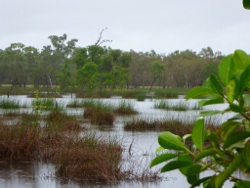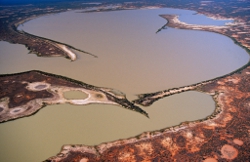|
|
Water (chemical and quality)Pure water has no nutrients, sediments and is totally colourless and tasteless[2]. However, water in wetlands has a range of different characteristics, some are due to the natural variation in the substrate and surrounds and others to human activities (anthropogenic influences). The chemical components of water fundamentally affect what lives in the wetland and how the wetland functions and supports values. Chemical water attributes are used when applying the Queensland wetland habitat classification scheme to lacustrine and palustrine wetlands. Intertidal and subtidal wetlands contain saline water due to their links with oceanic water. Other wetland systems may contain saline water as a result of their substrate or water source, e.g. some spring fed wetlands have high levels of salts and other minerals. Other physical components, such as pH and water hardness, also tend to reflect aspects of the wetlands substrate, soils and sediments or water source. The vegetation, surrounding land uses, light availability, position in the catchment and many other aspects also influence the chemical components of water. Some wetlands have a naturally low dissolved oxygen content in the water, high levels of nutrients and a strong odour. This is due to natural processes occurring within the wetland, e.g. higher amounts of organic material may lead to a lower dissolved oxygen level, as decomposition requires oxygen and thus reduces the dissolved oxygen content of the water. High rates of decomposition can result in a decline in water quality and impair aquatic life. However decomposition in wetlands also binds excess nutrients, metals etc. to soil or can release some nutrients such as carbon and nitrogen into the atmosphere.[1] Natural variation between wetlands is common, a good example of this is Lake Numalla and Lake Wyara. Both lakes are on the western edge of the Murray-Darling Basin but each lake has its own catchment. Lake Numalla (almost 3000ha) is a freshwater lake while Lake Wyara (3800ha), less than 3km away, is saline. Lake Wyara fills entirely from its local catchment which has high salt levels. Find out more on the Currawinya National Park Nature, culture and history page. Additional linksPages under this sectionReferences
Last updated: 13 September 2023 This page should be cited as: Department of Environment, Science and Innovation, Queensland (2023) Water (chemical and quality), WetlandInfo website, accessed 8 May 2025. Available at: https://wetlandinfo.des.qld.gov.au/wetlands/ecology/components/water-chemical/ |

 — Department of the Environment, Tourism, Science and Innovation
— Department of the Environment, Tourism, Science and Innovation



